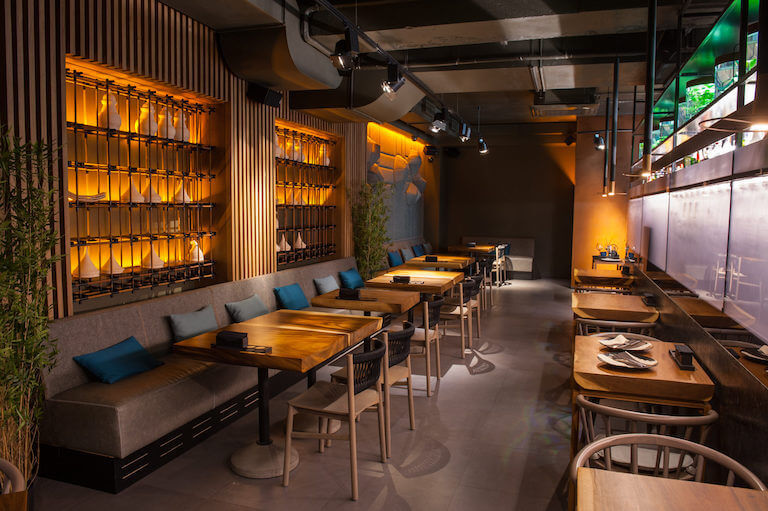Savor Genuine Oriental Cuisine With a Pan-Asian Twist for a Culinary Adventure
Getting started on a cooking journey via genuine Asian food, enhanced with a Pan-Asian twist, provides a special opportunity to explore the rich tapestry of flavors that specify the region's varied cooking practices. This experience welcomes you to savor the charming balance of preferences-- sweet, salted, spicy, and sour-- harmonized by aromatic natural herbs and spices. Envision the cutting-edge blend of Thai curry and ramen or the unforeseen delight of sushi burritos. As you ponder these luring meals, think about the cultural stories and historic impacts that form them, each bite supplying a tale waiting to be found.

Exploring Pan-Asian Flavors
In the realm of worldwide gastronomy, Pan-Asian food attracts attention for its exceptional diversity and the unified interplay of tastes from various Oriental cultures. This culinary approach celebrates the one-of-a-kind active ingredients and abundant practices discovered throughout the continent, producing a tapestry of tastes that is both appealing and enjoyable. Key to Pan-Asian food is its capability to stabilize different flavors-- sweet, salted, spicy, and sour-- while highlighting the quality and high quality of each component.
From the umami-rich soy sauce of Japan to the intense chili peppers of Thailand, Pan-Asian food uses a considerable palette of flavors. These components are typically combined in creative ways, enhancing recipes with layers of complexity. For circumstances, using aromatic herbs such as lemongrass and cilantro, usual in Vietnamese and Thai cuisine, adds a refreshing brightness to meals, while the incorporation of coconut milk provides a luscious, abundant texture.
The emphasis on fresh fruit and vegetables and fragrant spices makes sure that each meal is not only a feast for the preference buds yet additionally for the detects. Pan-Asian food invites restaurants to start a cooking journey, exploring the large and varied landscapes of Oriental gastronomy with every bite.
Combination Dishes to Attempt
While Pan-Asian cuisine is celebrated for its typical tastes, the contemporary cooking landscape is progressively accepting combination dishes that mix these classic elements with influences from various other regions. This innovative strategy not only honors the rich heritage of Eastern culinary arts but also introduces unique preference experiences that appeal to contemporary tastes.
An archetype of such a fusion dish is the Korean-Mexican taco, where marinaded bulgogi beef is covered in a warm tortilla, topped with kimchi and a zesty gochujang-infused salsa. This combination weds the strong, mouthwatering tastes of Korea with the vibrant, fresh elements of Mexican food. Likewise, sushi burritos have gained popularity, amalgamating the fragile artistry of Japanese sushi with the passionate, hand-held convenience of a burrito, usually including fusion active ingredients like tempura shrimp and avocado with a drizzle of wasabi mayo.
One more noteworthy meal is Thai curry ramen, which infuses the velvety, aromatic spices of Thai curry into the comforting brew of traditional Japanese ramen, producing a harmonious blend that entices the senses. These blend recipes prolong past plain novelty; they represent a cooking dialogue between societies, motivating expedition and innovation in the world of Pan-Asian cuisine.
Crucial Ingredients and Flavors
To really value Pan-Asian food, one must recognize the important components and seasonings that create its structure. This diverse cooking design draws from an abundant tapestry of Eastern customs, utilizing a harmonious mix of structures and tastes. Key active ingredients include soy sauce, fish sauce, and oyster sauce, which impart a mouthwatering umami depth vital to Asian dishes. Corresponding to these are rice vinegar and mirin, providing a delicate acidity and sweetness.
Fragrant elements are crucial, with garlic, lemongrass, and ginger being ubiquitous throughout numerous Pan-Asian dishes. These ingredients provide a fragrant base that improves the intricacy of flavors. Seasonings such as star anise, cardamom, and cinnamon introduce warmth and personality, resembling impacts from regions like China and India.

Food Preparation Techniques and Tips
Mastering the art of Pan-Asian food calls for familiarity with its distinctive cooking techniques, each contributing to the dynamic tapestry of kfc coupons flavors this culinary custom is commemorated for. Central to these techniques is the stir-fry, a quick cooking strategy that protects the dietary stability and vibrant colors of ingredients. Using a frying pan, the stir-fry method permits even warmth circulation, important for attaining the particular structure and flavor balance of Pan-Asian recipes.
An additional basic technique is steaming, especially prevalent in Chinese food. This gentle approach maintains the all-natural flavors and nutrients of components, making it perfect for seafood and veggies. Dumplings, a cherished staple, typically gain from steaming, leading to soft, delicious structures.
Cooking, likewise integral, gives great smoky midsts to dishes such as Oriental bulgogi or Japanese yakitori (Instagrammable restaurants Islamabad). This method commonly involves marinating ingredients, enabling tastes to penetrate deeply prior to cooking over an open flame or warmer
Finally, grasping the art of balancing flavors-- wonderful, sour, salted, bitter, and umami-- is critical. Correctly layering these components can boost a meal from average to extraordinary, using a facility and pleasing cooking experience that symbolizes the essence of Pan-Asian cuisine.
Eating Experiences Worldwide
Throughout the globe, Pan-Asian food provides an unequaled dining experience, celebrated for its abundant tapestry of flavors and read this lively presentations. This culinary sensation has gone beyond cultural boundaries, capturing the hearts and tastes buds of food enthusiasts worldwide. In multicultural cities fresh York, London, and Sydney, Pan-Asian restaurants offer as melting pots where cooking traditions from Thailand, Japan, China, and past merge, offering restaurants with a diverse mix of dishes that highlight the area's variety.
The international allure of Pan-Asian food lies in its ability to provide both authenticity and technology. Cooks masterfully wed traditional ingredients such as lemongrass, soy sauce, and miso with contemporary techniques, resulting in meals that are both acquainted and refreshingly brand-new. This blend allows restaurants to embark on a cooking trip that values heritage while welcoming modernity.
Moreover, eating experiences are boosted via attentively made settings that mirror the values of Pan-Asian aesthetic appeals. From minimalist Japanese-inspired interiors to vibrant Thai-themed spaces, each dining establishment supplies an unique ambiance that enhances the cooking offerings. Consequently, clients are not just consuming a meal however partaking in a cultural experience, making Pan-Asian dining a genuinely global sensation.
Verdict
The expedition of Pan-Asian cuisine offers an extensive understanding of the detailed interaction of tastes and cooking traditions throughout Asia. By accepting combination dishes such as Thai curry ramen and sushi burritos, the culinary trip not only highlights the adaptability of conventional ingredients however also showcases innovative contemporary techniques. This gastronomic journey, enhanced by cooking techniques and vital spices, supplies a distinct possibility to appreciate the social diversity and cooking creativity that specify Pan-Asian food on a global range.
Embarking on a cooking trip with authentic Oriental cuisine, enhanced with a Pan-Asian twist, supplies a distinct possibility to check out the abundant tapestry of flavors that define the area's diverse culinary practices.In the realm of worldwide gastronomy, Pan-Asian food stands out for its amazing variety and the unified interplay of flavors taco bell near me from different Eastern societies. Key to Pan-Asian food is its capacity to balance contrasting tastes-- pleasant, salty, spicy, and sour-- while highlighting the freshness and high quality of each active ingredient.
